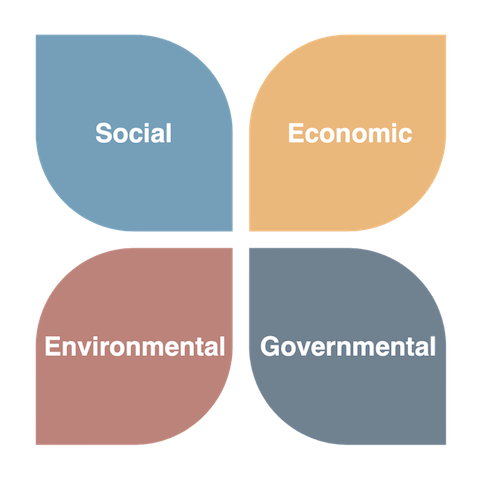Blockchain in the real economy: an overview of use cases and sustainability goals
This article provides a brief overview of potential blockchain usage in major real economy sectors and their relationship to the four pillars of urban sustainability.

Note: this article is an abridged version from the corresponding part of the "Blockchain for Cities research"
Blockchain technology is one of the disruptive digital technologies that have garnered considerable attention in recent years. While it is initially used by cryptocurrency Bitcoin in the financial domain, many people believe blockchain could also be adopted in the real economy to improve society in terms of transparency, efficiency, inclusiveness, and sustainability. A large number of cities around the world have considered blockchain an important part of the overall smart city infrastructure and reported all kinds of blockchain-related initiatives.
Below are summarized findings from the "Blockchain for Cities research" paper on potential blockchain use cases in urban real economy sectors and their relationship to urban sustainability goals.
Blockchain use cases in major sectors
Energy and environment
In the energy domain, an important blockchain application is for decentralized energy trading on the grid. Mass deployment of rooftop solar photovoltaic cells makes electricity consumers also electricity producers (prosumers). Blockchain enables a peer-to-peer market where these residential or commercial solar prosumers can sell their excess power to the grid or other parties. This not only reduces their own bills but also improves resiliency in the grid. The Brooklyn Microgrid is an actual system that already operates in New York City.
Electric Vehicles (EVs) can also leverage blockchain technologies to directly interact with the grid. That could allow them to autonomously select appropriate charging stations and improve the recharging process with the desired security and cost requirements. The EVs can also trade electricity back to the grid similar to the solar energy prosumers.
In the natural environment domain, blockchain-based systems can be used in creating a peer-to-peer marketplace for carbon credit trading.
Transportation
A simple application in the transportation domain can be creating a blockchain-based repository for all the vehicle life cycle information. Such a system can help reduce odometer and other vehicle-related frauds and have a big impact on the industry.
Blockchain can be used in enabling peer-to-peer communications between cars and all intelligent objects in the transportation system. Vehicle-to-Everything communication is a key component for an intelligent transportation system that improves efficiency in traffic and transport management. The blockchain-based decentralized method solves the scalability problem in the current centralized model.
Online ride-sharing is another example of blockchain applications in the transportation area. The blockchain-based decentralized ride-sharing solution provides better personal privacy protection as no central intermediary can track the user's itinerary.
In the global goods transportation area, blockchain can be used in digitizing the exchange of shipping documentation, bill of lading, and compliance information, reducing the cost for global trade.
Well-being, Health, and Safety
Medical data are highly privacy sensitive. In the healthcare domain, blockchain systems can be used to improve the tracking of each step in the clinical trial process. It can also help create a system for secure collection and access of medical records by patients, providers, and third parties.
The medical supply chain may benefit from blockchain technology as well. A blockchain system can help trace the origins of drugs to prevent counterfeits. It can also track the regulatory compliance and quality control during the transportation process of the drugs. The system can further keep an immutable record of drug transactions among all the stakeholders such as manufacturers, wholesalers, retailers, pharmacies, hospitals, and consumers.
Insurance is also an area that could have interesting blockchain applications. On one hand, applying blockchain to the insurance life cycle could help improve transparency and reduce fraudulent claims. On the other hand, blockchain could enable new types of micro-insurance use cases such as a pay-as-you-go, which allows drivers who rarely use cars to only pay an insurance premium for particular trips they would like to travel.
Business and commerce
The common E-commerce marketplace can be built on blockchain to enable a decentralized model and allow buyers and sellers to transact directly without a central intermediary. This peer-to-peer payment model is especially important for enabling direct machine-to-machine transactions and human-machine hybrid transactions. Those new types of transactions open the door for a significant number of new applications in the Web 3.0 era when billions of intelligent objects (machines) are expected to become part of the web. One example of machine-to-machine payment could be electricity payment directly by the smart socket over the blockchain.
Architecture, Engineering, and Construction (AEC)
Blockchain technology can play important roles in the Architecture, Engineering, and Construction (AEC) industry. Projects in this industry involve a diverse range of stakeholders, such as owners, designers, clients, contractors, and suppliers. The transparency feature brought by blockchain could enhance the trust relationship among this group of collaborators, which helps to ensure the project's success. Examples of possible blockchain usage in the construction industry include notarization applications to eliminate the verification time of construction documents authenticity, transaction applications to facilitate automated procurement and payment, and provenance applications to improve transparency and traceability of construction supply chains.
Education, Science, and Innovation
The education sector can use blockchain's immutability feature to counter fraud. A blockchain-based publicly verifiable repository can be maintained for all types of records, such as diplomas and credentials, course completion certificates, or even volunteering services records.
In the science innovation area, an inventor can use blockchain to timestamp an idea. This allows the public to verify when and who invented the idea, which could be crucial when applying for Intelectual Properties (IP) protections. Blockchain can further be used to enforce IP protections. For example, license distribution of digital products such as software and digital media can be tracked and verified on the blockchain.
Governance and citizen engagement
At a basic level, blockchain can help create an immutable and transparent repository for government record-keeping. These records are verifiable by the public and the access history of all the records can also be preserved.
Blockchain can be used to improve two of the fundamental processes in governance - one is voting, which forms the government, and the other is taxation, which finances the government. A blockchain-based electronic voting system could help improve transparency while also maintaining anonymity and privacy. On the blockchain for the taxation use case, one can imagine that if all the taxable transactions were kept in an immutable record on a blockchain, it makes it much straightforward both for the tax authorities and the taxpayer to calculate and enforce the tax payments and refunds. There are certainly many practical aspects that have to be factored in to create such systems.
At a more advanced level, blockchain can become the basis of a collaborative urban policy-making framework. An example is illustrated by Marsal-Llacuna. Citizens submit their urban needs to the blockchain, which will be prioritized by a blockchain consensus mechanism for the authorities to draft policies. These drafts will be ratified through the blockchain validation capabilities. Further transform of these plans into physical forms (e.g., construction of infrastructure projects) can be approved via voting mechanisms on the blockchain as well. The plans and regulations can also be standardized for replicability and scalability purposes, using the same bottom-up approach for citizen participatory standardization. Notice that a distinctive feature of this framework is that it is a decentralized system, so it is not dominated by any central entity.
Blockchain use cases and urban sustainability goals

Social, economic, and environmental constitute United Nations's triple bottom line on sustainability development. All these three areas of sustainability are represented in various degrees in the use cases we surveyed.
The social domain focuses on people. In this respect, the well-being, health, and safety area is a heavily examined sector focusing especially on electronic health records, drug, and food safety-related use cases. Education and culture are well represented mainly in improving the learning system and educational resource planning, as well as solving transparency problems in certain cultural entertainment programs. In contrast, the number of systems addressing the built environment is relative few, and there is a lack of social diversity-centered cases.
In the economic domain, we see a large number of cases focusing on transforming commerce, sharing economy, collaborative business, and other related aspects to improve prosperity. There are also efforts centered on enhancing the collaborative scientific research process to stimulate more innovations. Applications in transportation such as the advancement of the global goods supply chain and intelligent transportation systems are bringing significant impact to both businesses and consumers in many other sectors of the society, potentially contributing to economic boost as well.
The environmental domain applications have concentrated on the green energy sector, manifested by numerous use cases concerning electricity prosumers, microgrids, and electric vehicles, as well as peer-to-peer energy trading and supply-demand balances. Air quality, carbon emission, sand mining have also been covered. However, there are in general fewer discussions on many topics in this domain such as on materials, water and land, waste management, and climate resilience.
Last but not least, the governmental domain is often considered the fourth pillar of sustainability because of its unique impact on all the social, economic and environmental sectors. Our findings on the governance and citizen engagement sector show that blockchain use in this domain is very much in line with and even provides crucial compliments to existing initiatives in meeting challenges for a truly citizen-empowered collaborative governance infrastructure.
Conclusions and challenges
We provided a brief list of potential or existing blockchain use cases in major sectors of our real economy and discussed their relationship with the four pillars of urban sustainability goals. Despite the diversity in the application domain, they all leverage the core characteristics that blockchain technology carries. These features start with a distributed ledger containing immutable records, which brings transparency. This transparency further enables a trustless environment, which allows parties to conduct peer-to-peer transactions without an intermediary. Such a peer-to-peer model is important for human-based transactions but is even more significant for machine-based transactions because that could be the only way to integrate tens of billions of intelligent objects (machines) into the upcoming Web 3.0.
While blockchain technologies can be a disruptive force in all the different real economy sectors, we have to also understand that it will take time for us to get there. Blockchain technology itself is still under rapid development and is far from mature for many of the applications we mention.
Even if we already have the perfect blockchain technology, another wide-open challenge is the interface between the blockchain and its external world. All blockchain use cases in the real economy need the blockchain to interact with the real world, which inherently requires information not available to the blockchain itself. If the quality of this external input information cannot be guaranteed, whatever output the blockchain system produces will be useless. Imagine we have the best blockchain-based voting system that can absolutely secure all votes in the system. What if the voting record is tempered before it even gets onto the blockchain? That is why blockchain for real-economy cases is much harder than those that do not require external information input. That said, both blockchain and its interface to the real world are under intensive development and we are expecting a promising future.
Note: this article is part of my Introduction to Blockchain, Crypto, Metaverse and Web3: Beyond the Hype. You may find the rest of the articles in the series here.

